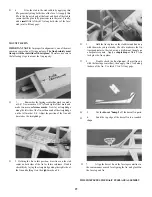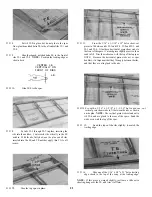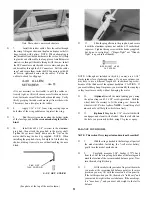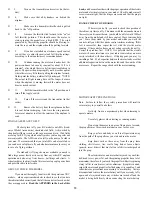
D 5. Turn on the transmitter and receiver (in that or-
der).
D 6. Make sure that all bystanders are behind the
airplane.
D 7. Make sure the transmitter throttle stick is pulled
back to the "off position.
D 8. Advance the throttle stick forward to the "on" (or
full throttle) position. This should cause the motor to
start, spinning the propeller at a high RPM. The wind
generated by the rotating propeller should be blowing to-
ward the rear, and the airplane should be pulling forward.
D 9. If you have installed an electronic speed control,
you will have to adjust the neutral and full throttle settings.
according to the manufacturer's recommendations.
D 10. Continue running the motor and notice how the
power continues to be nearly constant for about 3-1/2 to 4
minutes*, after which there is a definite noticeable drop in
power. The power then drops rapidly until it reaches a point
where there is very little thrust pulling the airplane forward.
At this point the battery is almost fully discharged. *NOTE:
The actual in-flight running time will be longer, because
when the airplane is moving forward the motor does not
draw as much current
D 11. Pull the transmitter stick to the "off position, and
turn off the toggle switch.
D 12. Turn off the receiver and the transmitter (in that
order).
D 13. Remove the battery from the airplane and allow
it to cool before recharging. Also leave the wing removed
for several minutes to allow the interior of the airplane to
cool.
FIND A SAFE PLACE TO FLY
The best place to fly your R/C model is an AMA (Acad-
emy of Model Aeronautics) chartered club field. Ask your hobby
shop dealer if there is such a club in your area and join. Club fields
are set up for R/C flying which usually makes your outing safer and
more enjoyable. The AMA can also tell you the name of a club in
your area. We recommend that you join AMA and a local club so
you can have a safe place to fly and also have insurance to cover you
in case of a flying accident.
If a club and its flying site are not available, you need to
find a large area at least 6 miles away from any other R/C airplane
operation and also away from houses, buildings and streets. A
schoolyard may look inviting but it is too close to people, power lines
and possible radio interference.
GROUND CHECK THE MODEL
If you are not thoroughly familiar with the operation of R/C
models, ask an experienced modeler to check to see that you have
the radio installed correctly and that all the control surfaces do what
they are supposed to. Read the APPENDIX in the back of this
book, and become familiar with the proper operation of the electric
motor and electrical system in your model. Check to make sure all
screws remain tight, that the hinges are secure and that the prop is
on tight.
RANGE CHECK YOUR RADIO
Wherever you do fly, you need to check the operation of
the radio every time you fly. This means with the antenna down, and
the receiver and transmitter on, you should be able to walk 100 feet
away from the model and still have control. Have someone help
you. Have them stand by your model and while you work the
controls, tell you what the various control surfaces are doing. If this
test is successful, then repeat the test with the electric motor
running. If the control surfaces are not acting correctly, do not fly.
Correct the problem first. NOTE: It is possible that the electric
motor will cause interference to your radio (some radios are more
easily interfered with than others). If this happens, you may try
installing a 2nd. .01 uF capacitor between the motor leads, or solder
additional capacitors between the motor tabs and the outside of the
motor case. Repeat the range check with the motor running.
MOTOR SAFETY PRECAUTIONS
Note: Failure to follow these safety precautions will result in
severe injury to yourself and others.
Get help from an experienced pilot when learning to
operate motors.
Use safety glasses when starting or running motors.
Do not run the motor in an area of loose gravel or sand;
the propeller may throw such material in your face or eyes.
Keep your face and body as well as all spectators away
from the path of the propeller as you start and run the motor.
Keep items such as these away from the prop: loose
clothing, shirt sleeves, ties, scarfs, long hair or loose objects
(pencils, screw drivers) that may fall out of shirt or jacket pockets
into the prop.
The electric motor and motor battery used in your Elec-
troStreak is very powerful, and the spinning propeller has a lot of
momentum; therefore, if you touch the propeller while it is spinning
it may inflict severe bruises, cuts or abrasions. Keep this in mind,
respect the motor and propeller for the damage it is capable of, and
take whatever precautions are necessary to avoid injury. Always
disconnect and remove the motor battery until you are ready to fly
again, and always make sure any switches are turned off and the
model is being held firmly when connecting the motor battery.
33








































